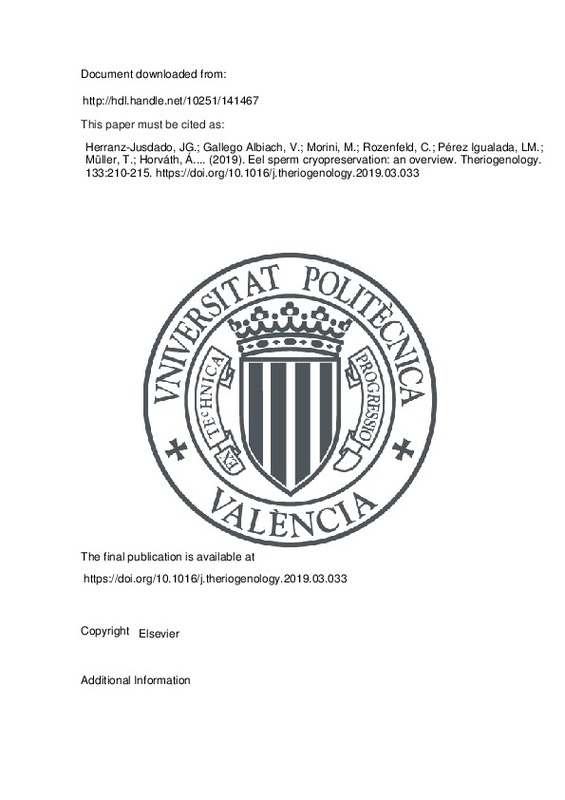Herranz-Jusdado, JG.; Gallego Albiach, V.; Morini, M.; Rozenfeld, C.; Pérez Igualada, LM.; Müller, T.; Horváth, Á.... (2019). Eel sperm cryopreservation: an overview. Theriogenology. 133:210-215. https://doi.org/10.1016/j.theriogenology.2019.03.033
Por favor, use este identificador para citar o enlazar este ítem: http://hdl.handle.net/10251/141467
|
Título:
|
Eel sperm cryopreservation: an overview
|
|
Autor:
|
Herranz-Jusdado, Juan Germán

 Gallego Albiach, Victor
Gallego Albiach, Victor

 Morini, Marina
Rozenfeld, Christoffer
Morini, Marina
Rozenfeld, Christoffer

 Pérez Igualada, Luz María
Müller, T.
Horváth, Ákos
Ohta, H.
Pérez Igualada, Luz María
Müller, T.
Horváth, Ákos
Ohta, H.

 Asturiano Nemesio, Juan Francisco
Asturiano Nemesio, Juan Francisco
|
|
Entidad UPV:
|
Universitat Politècnica de València. Departamento de Ciencia Animal - Departament de Ciència Animal
Universitat Politècnica de València. Instituto de Ciencia y Tecnología Animal - Institut de Ciència i Tecnologia Animal
|
|
Fecha difusión:
|
|
|
Resumen:
|
[EN] The eels are teleost fishes from the order Anguilliformes that includes several species with high commercial value. Due to the high interest for aquaculture production of some eel species and for the need to restore ...[+]
[EN] The eels are teleost fishes from the order Anguilliformes that includes several species with high commercial value. Due to the high interest for aquaculture production of some eel species and for the need to restore eel species that are endangered, several research groups have directed their research toward developing protocols to cryopreserve the spermatozoa of Japanese eel (Anguilla japonica) and European eel (Anguilla anguilla). In this review, we provide an overview on the different protocols that have been developed so far. The first developed protocols used DMSO as cryoprotectant in both species with good success, obtaining sperm motilities of over 45% in Japanese eel and over 35% in European eel. Moreover, sperm cryopreserved using DMSO was successfully used in fertilization trials, although with low fertilization rates. However, recent studies show that DMSO produce epigenetic changes in eel sperm and therefore, the last developed protocols used methanol as cryoprotectant instead. Cryopreservation protocols using methanol as cryoprotectant, showed improved motility values in both Japanese and European eel. In addition, the latest protocols have been adapted to cryopreserve larger volumes of sperm of up to 5¿mL, which is useful for larger scale fertilization trials.
The present study introduces the state of the art and future perspectives of the eel sperm cryopreservation to be applied in aquaculture and biological conservation programs.
[-]
|
|
Palabras clave:
|
Fish
,
Anguilla
,
DMSO
,
Methanol
,
Spermatozoa motility
,
Vitrification
|
|
Derechos de uso:
|
Reconocimiento - No comercial - Sin obra derivada (by-nc-nd)
|
|
Fuente:
|
Theriogenology. (issn:
0093-691X
)
|
|
DOI:
|
10.1016/j.theriogenology.2019.03.033
|
|
Editorial:
|
Elsevier
|
|
Versión del editor:
|
https://doi.org/10.1016/j.theriogenology.2019.03.033
|
|
Código del Proyecto:
|
info:eu-repo/grantAgreement/UPV//PAID-10-18/
info:eu-repo/grantAgreement/EC/H2020/642893/EU/Improved production strategies for endangered freshwater species./
info:eu-repo/grantAgreement/Ministry of Human Capacities//EFOP-3.6.3-VEKOP-16-2017-00008/
info:eu-repo/grantAgreement/Ministry of Human Capacities//1783-3%2F2018%2FFEKUTSRAT/
info:eu-repo/grantAgreement/AEI//IJCI-2017-34200/
|
|
Agradecimientos:
|
Funded by the European Union's Horizon 2020 research and innovation program under the Marie Sklodowska-Curie grant agreement N 642893 (IMPRESS), including the JGHJ and CR pre-doctoral contracts. MM has a postdoc grant from ...[+]
Funded by the European Union's Horizon 2020 research and innovation program under the Marie Sklodowska-Curie grant agreement N 642893 (IMPRESS), including the JGHJ and CR pre-doctoral contracts. MM has a postdoc grant from the UPV (PAID -10-18). VG has a postdoc grant from the MICIU (Juan de la CiervaIncorporacion; IJCI-2017-34200). This research was supported by the Higher Education Institutional Excellence Program (1783-3/2018/FEKUTSRAT) awarded by the Ministry of Human Capacities of Hungary within the framework of water related researches of Szent Istvan University as well as the EFOP-3.6.3-VEKOP-16-2017-00008 project co-financed by the European Union and the European Social Fund.
[-]
|
|
Tipo:
|
Artículo
|







![[Cerrado]](/themes/UPV/images/candado.png)


